#ichthyosaurs
Explore tagged Tumblr posts
Text

swordfishes your lizard
622 notes
·
View notes
Text
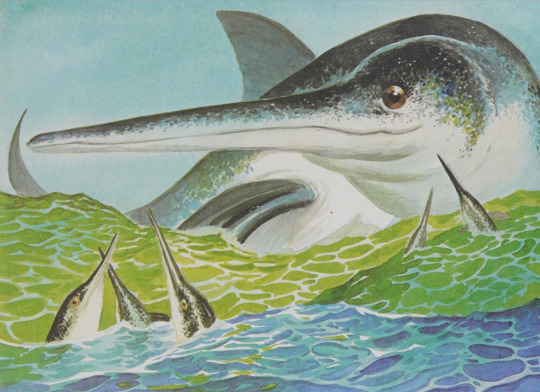
Sea Monsters; Ancient Reptiles that Ruled the Sea. Written by David Edlridge, illustrated by Norman Nodel. 1980.
Internet Archive
1K notes
·
View notes
Text

My 25 years of palaeoart chronology…
The 2022 Korean translation of Locked in Time (by Dr Dean Lomax - Palaeontologist & published by Columbia University Press) commissioned me to colourise my 50 greyscale illustrations. Here's "The Transient Oasis," showing a colony of Seirocrinus crinoids drifting on deadwood.
#Art#Painting#PaleoArt#PalaeoArt#SciArt#SciComm#DigitalArt#Illustration#Dinosaurs#Birds#Pterosaurs#Reptiles#MarineReptiles#Palaeontology#Paleontology#Seirocrinus#Crinoids#Ichthyosaurs#Ichthyosaurus#JurassicPark#JurassicWorld
80 notes
·
View notes
Text



Marine Reptiles of the Mesozoic
Intros of the videos I made of The holy Trinity of ´Sea Dragons´ of the Mesozoic: Ichyosaurs, Plesiosaurs and Mosasaurs
___
Youtube Channel
Instagram (new account)
Prints and more items of my artwork
#paleontology#cladistics#evolutionary aesthetics#sauropterygia#plesiosaurs#mosasaurs#ichthyosaurs#triassic#jurassic#cretaceous#evolution#marine reptiles
40 notes
·
View notes
Note
Potentially dumb question but how do Ichthyosaurs and Pliosaurs fit into everything? Are they more closely related to crocodiles or birds?
And (I'm hesitant to ask this but) are they technically fish in the same way all mammals and thus whales could be argued to be technically fish? (If I've now accidentally made this ask cursed, feel free to delete).
So we don't know where Ichthyosaurs or Plesiosaurs (which includes Pliosaurs) go, exactly, but they aren't more closely related to crocs or birds! They might be close to turtles, or not close to any living reptile group at all. They're an enigma
Mosasaurs, however, are straight up lizards. Like actual giant lizards. We don't know whether they're closer to snakes or monitor lizards, but they're lizards
And yup, aaaaaall of them are fish
173 notes
·
View notes
Text
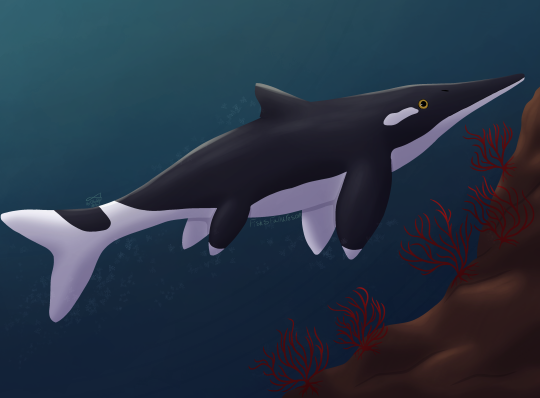
A Temnodontosaurus swimming through the ocean. Apparently this is the first ichthyosaur I've drawn, at least since I got my old laptop that I had for six/seven years lmao.
#art#my art#digital art#paleoart#paleontology#palaeoblr#marine reptiles#ichthyosauromorphs#ichthyosaurs#temnodontosaurus#queue
33 notes
·
View notes
Text
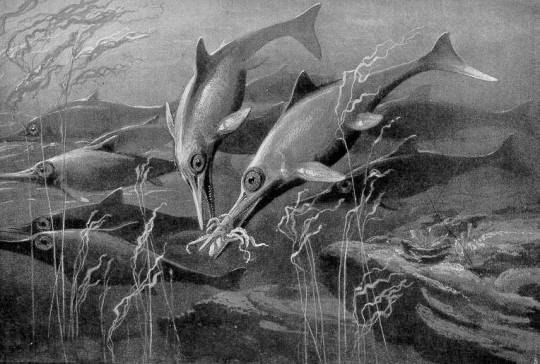






The marine paleoart of Heinrich Harder, 1858-1935. Most of these were created for collectible cards and prints between 1910 and 1920.
#paleoart#vintage paleoart#heinrich harder#ichthyosaurs#mosasaurs#trilobites#the sea and what lives in it
14 notes
·
View notes
Text
In the spring of last year, I made several color reconstructions of marine reptiles for a thesis and presentation (it was about the reconstruction of marine reptiles) for a conference that was held in Ulyanovsk in September. The drawings were done in ballpoint pen (lineart) and Paint Tool Sai 2.0 (shadows and colors).

The first is reconstruction of Mixosaurus cornalianus, a widespread small Triassic ichthyosaur. I had already drawn a Mixosaurus in water earlier and even wanted to use it in the article, but later changed my mind, deciding that lateral reconstruction would better convey the appearance of soft tissues. This earlier drawing can bee seen here:

Both pieces are based on the fin impressions described in 2020 from a specimen found in the Middle Triassic rocks of the Bezano formation, Italy (www.researchgate.net/publicati…). This specimen has preserved the tissues of the dorsal and caudal fins. Both prints have thin collagen filaments, and at the base of the caudal fin, it was possible to detect the remains of smooth, scaleless skin. The fins have a triangular shape, and the dorsal one is associated with 15-23 trunk vertebrae. In other words, its position turned out to be more
forward then in reconstructions done before his paper.

The second is lateral reconstruction of the metriorhynchid Cricosaurus albersdoerferi, belonging to a widespread genus that inhabited the shallow seas of future Europe, Central America and Argentina. It was not a particularly large animal, reaching from 2 to 3.2 meters in length. Like the first reconstruction of a Cricosaurus, which I performed in the spring, this drawing is based on a specimen that preserved a large volume of soft tissue on the tail (upload.wikimedia.org/wikipedia…). Also shown here is the salt gland in the antorbital fenestra, the presence of which was previously indicated in Cricosaurus araucanensis and Dakosaurus andiniensis. The spring work with C. albersdoerferi can be seen below:
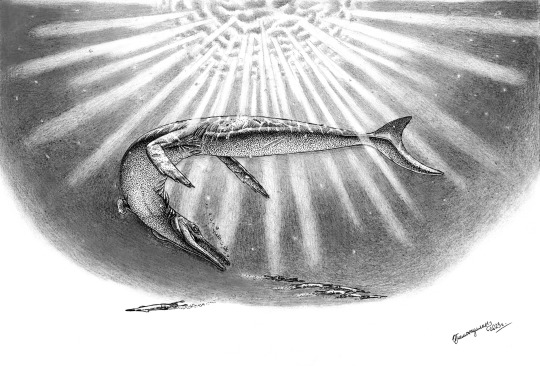

Plesiosaurs are mentioned too. This is reconstruction of the polycotylid Mauriciosaurus fernandezi from the Late Cretaceous of Mexico. A complete reptile skeleton preserved in fine-grained rocks was described by a team of paleontologists in 2017: www.researchgate.net/publicati… There are five types of soft tissue imprints around the bones. Among them are dark material, probably left from the walls of the peritoneum, dark gray traces of blubber and impressions of possible small scales. The impressions show that the animal's belly was covered with rectangular scales, which were mixed with inclusions of small fragments closer to the limbs. The scales of the living reptile were almost indistinguishable, so that the skin looked smooth. This beautifully preserved specimen showed that plesiosaurs had much more soft tissue than previously thought. The tail was especially fleshy. Fat deposits created a smooth, streamlined shape, ideal for an agile swimmer.

The last thesis drawing is this reconstruction of the famous Early Jurassic ichthyosaur Stenopterygius quadriscissus. Many of its skeletons of amazing preservation were found in the fine-grained limestones of Holzmaden, Germany. Some of them were discovered back in the 19th century, which made it possible to quickly correct previous ideas about ichthyosaurs. The Stenopterygius specimens retained soft tissue prints in the form of a bacterial film, which made it clear that they were fish-like creatures with a dorsal fin and a crescent tail. They re still attract the attention of researchers. In 2018, the skin structure of one partial specimen was studied: www.researchgate.net/publicati… A fossilized blubber was described, similar in microstructure to that of marine mammals and leatherback turtles. This led to the conclusion that ichthyosaurs were reptiles with a high metabolism, which required fat insulation. Blubber allowed ichthyosaurs to travel across the oceans, swimming even into the cold polar waters. In addition, this Stenopterygius had pigment cells - melanophores. They were absent on the ventral side, which means that the Stenopterygius had a dark back and a light belly. This countershading coloring is typical of today's marine vertebrates and serves as a camouflage.
I did also three works in fully traditional style, with pens and pencils, but I'll show them in the separate post. :)
#mixosaurus#stenopterygius#ichthyosaurs#cricosaurus#metriorhynchidae#mauriciosaurus#polycotylidae#plesiosaur#mesozoic marine reptiles#paleoart
31 notes
·
View notes
Text

#id in alt text#Peter Goodfellow#Jack L. Chalker#dinosaurs#paleoart#Midnight at the Well of Souls#ichthyosaurs#Theropods
30 notes
·
View notes
Text
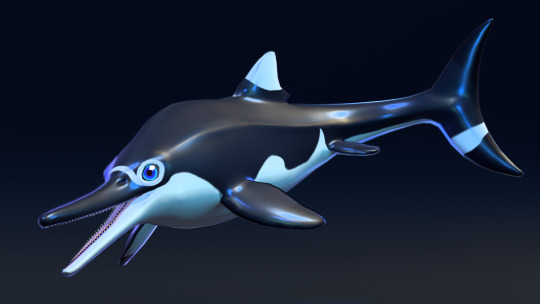

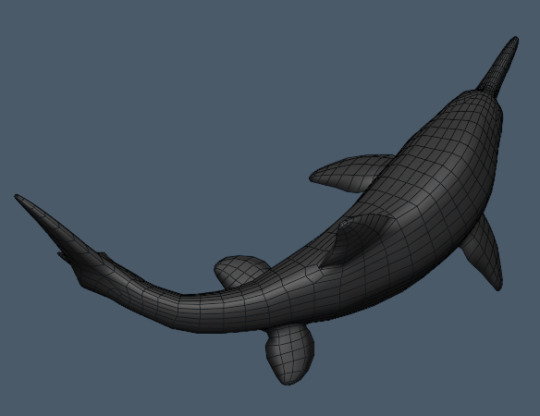
big eyed dolphin lizard
196 notes
·
View notes
Text
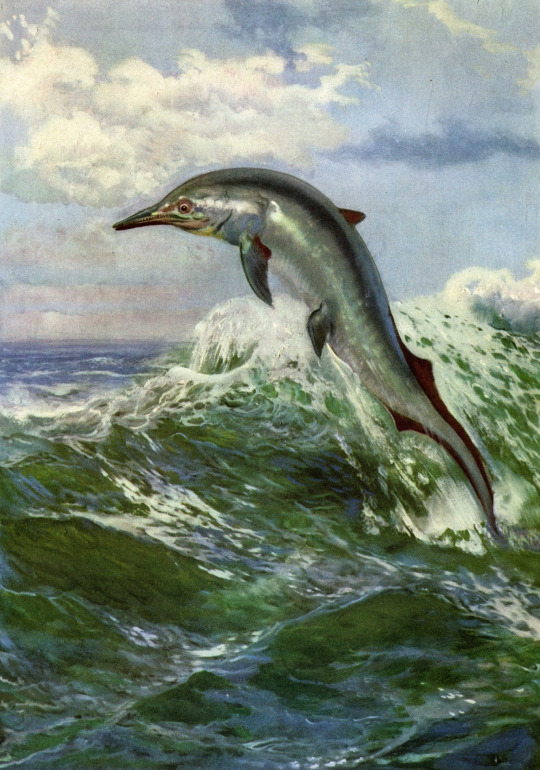
"The Triassic sea was the home of the largest Ichthyosaurs, the best known of which was Mixosaurus, with its long, low tail fin and elongated snout armed with large numbers of teeth fixed in sockets. It grew to a length of over 6 feet."
Prehistoric Sea Monsters. Written by Dr. Josef Augusta. Illustrated by Zdeněk Burian. 1966.
Internet Archive
576 notes
·
View notes
Text

My 25 years of palaeoart chronology…
In 2021 I created a bunch of paintings for the Children's Museum of Indianapolis, USA. I painted four murals and three illustrations for graphics boards. Here's one of the illustrations featuring the ichthyosaur Baptanodon.
#Art#Painting#PaleoArt#PalaeoArt#SciArt#SciComm#DigitalArt#Illustration#Dinosaurs#Birds#Reptiles#Palaeontology#Paleontology#Baptanodon#Ichthyosaurs#JurassicWorld#JurassicPark
77 notes
·
View notes
Note
Everyone talks about spinosaurus but whenever I hear about Icthyosaurus they also just get more fucked up
its true. like wtf do you mean they evolved in the permian???
40 notes
·
View notes
Text
[Image Description: artwork depicting a bright yellow ichthyosaur swimming through green water, in pursuit of a fish. End image description.]

Maysozoic Day 9: Shonisaurus 🐋
(feat. birgeria)
764 notes
·
View notes
Text


Remember me and that is enough
[Image ID: A digital illustration of a school of Ichthyosaurs, a marine reptile shaped like a dolphin with a small fluke and paddle limbs, and a shark-like tail. They are all white, and some of them hold stars in their mouth. The biggest Ichthyosaur has a star in its eye, and they are swimming against a blue background. End ID.]
4K notes
·
View notes
